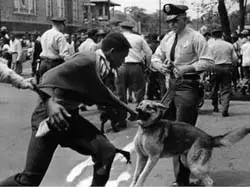Birmingham Campaign
Alabama is one of the southern states in the United States and, as many in the south, maintained policies of prejudice and discrimination against Black Americans after the Civil War. This continued, even though there were laws against it, until the Black leaders began to join forces to try to decide on the best way to protest and object.

The Civil Rights movement was born of these ideas of freedom and Birmingham was the capitol of Alabama and a center for much of the discrimination. The launch of the “Birmingham Campaign” was an example of how Black Americans could protest and bring the inequities to the American people.

In 1963, the activists of the Civil Rights movement had made the decision to design a plan of protest against the oppression of the discrimination practices in Birmingham. The official name was called “Project C” but it became commonly known as the Birmingham Campaign. The goal of the leaders was to establish nonviolent and peaceable protests that would get their message across.

Members of the Civil Rights Movement included the prominent leaders of the time, including Dr. Martin Luther King, Jr. who encouraged nonviolent protests. The plan was to have many of the local Black Americans stage lunch counter ‘sit-ins’ as well a march on City Hall in Birmingham.
They also planned to boycott any of the merchants downtown that supported segregation. During this time, most Black Americans were not allowed to eat in the same lunch areas as white Americans and this was an excellent way to show how oppressive the practice was.

During the next number of months there were a number of peaceful demonstrations that were held. They were met by Birmingham Police officers that attacked the demonstrators with dogs and high pressure fire hoses. These attacks were against peaceably walking men, women and children.

The images of the attacks were shown across the country on television and became some of the most disturbing and unsettling pictures of the Civil Rights Movement. In May, 1963, the Birmingham Campaign officially ended in a victory when the local officials agreed to the removal of the signs that were posted that said “White Only” and “Black Only” from the bathrooms and drinking fountains in downtown Birmingham.
They also agreed to desegregate the lunch counters and add a “Negro job improvement plan”. The demonstrators who had been arrested were released and the city officials agreed to set up a biracial committee that would monitor the agreements.

The process of desegregation happened slowly over the next months with some violent attacks from those that didn’t agree with it. This including the bomb that killed four young Black girls at the Sixteenth Street Baptist Church.
President John F. Kennedy, who had long supported equality stated “The events in Birmingham… have so increased the cries for equality that no city or state or legislative body can prudently choose to ignore them.”

The Birmingham Campaign was the major time in American history that was a turning point for the Civil Rights Movement and was a success for a start at changing the centuries of struggle for freedom by Black Americans.




